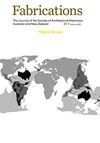From Hilltop Landmarks to Suburban Place Makers: Brisbane’s Post-War Religious Territories and Communities
IF 0.3
0 ARCHITECTURE
Fabrications-The Journal of the Society of Architectural Historians Australia and New Zealand
Pub Date : 2023-09-12
DOI:10.1080/10331867.2023.2249214
引用次数: 0
Abstract
This paper examines the shifting urban and architectural manifestations of Christian churches built in twentieth century Brisbane, the capital of Queensland and the third most populous city in Australia. In doing so, it considers how religious communities contributed to the formation of Brisbane’s modern cityscape. Based on texts published in the journals of Brisbane’s four largest Christian denominations, a chronological mapping of the development of the city’s religious territories from 1945 to 1977, and an architectural analysis of a select number of Brisbane churches, this paper demonstrates how during the post-war era Brisbane’s Churches shifted their urban planning approach from representational hilltop landmarks to community centres, and their architectural manifestation from grand (modern) monuments to suburban place makers. It also discusses what urban and community building strategies were pursued in this multi-denominational religious territory, and how this affected church architecture. While comparable shifts did occur elsewhere, both abroad and interstate, the paper argues that Brisbane, with its hilly topography, property-oriented religious leaders, and lack of government-funded community infrastructures, heightened opportunities for the Churches to use modern architecture and urban planning to express their faith and social values.从山顶地标到郊区场所制造者:布里斯班战后的宗教领土和社区
本文考察了建于20世纪布里斯班的基督教教堂的城市和建筑表现形式的变化,布里斯班是昆士兰州的首府,也是澳大利亚人口第三多的城市。在此过程中,它考虑了宗教社区如何对布里斯班现代城市景观的形成做出贡献。基于布里斯班四大基督教教派期刊上发表的文章、1945年至1977年城市宗教领域发展的时间顺序图,以及对布里斯班精选教堂数量的建筑分析,本文展示了战后布里斯班教堂如何将其城市规划方法从代表性山顶地标转变为社区中心。他们的建筑表现形式从宏伟的(现代)纪念碑到郊区的场所制造者。它还讨论了在这个多教派的宗教领域所追求的城市和社区建设策略,以及这对教堂建筑的影响。虽然类似的转变确实发生在其他地方,无论是国外还是州际,但论文认为,布里斯班的丘陵地形,以财产为导向的宗教领袖,以及缺乏政府资助的社区基础设施,为教会利用现代建筑和城市规划来表达他们的信仰和社会价值观提供了更多的机会。
本文章由计算机程序翻译,如有差异,请以英文原文为准。
求助全文
约1分钟内获得全文
求助全文
来源期刊

CiteScore
0.50
自引率
25.00%
发文量
26
 求助内容:
求助内容: 应助结果提醒方式:
应助结果提醒方式:


